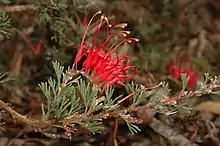| Spreading grevillea | |
|---|---|
 | |
| Grevillea humifusa in the Australian National Botanic Gardens | |
| Scientific classification | |
| Kingdom: | Plantae |
| Clade: | Tracheophytes |
| Clade: | Angiosperms |
| Clade: | Eudicots |
| Order: | Proteales |
| Family: | Proteaceae |
| Genus: | Grevillea |
| Species: | G. humifusa |
| Binomial name | |
| Grevillea humifusa Olde & Marriott[1] | |
Grevillea humifusa, commonly known as spreading grevillea,[2] is a species of flowering plant in the family Proteaceae and is endemic to a restricted area of the south-west of Western Australia. It is a prostrate shrub with long, trailing stems, divided lives with linear lobes and clusters of pink to pale red and cream-coloured flowers with a reddish, yellow-tipped style.
Description
Grevillea humifusa is a prostrate shrub with trailing stems typically up to 3 m (9.8 ft) long, its branchlets with long, soft hairs. Its leaves are divided, 15–20 mm (0.59–0.79 in) long with linear lobes 5–10 mm (0.20–0.39 in) long and about 0.5 mm (0.020 in) wide, the edges rolled under. The flowers are arranged in clusters of twelve to thirty on a silky-to woolly-hairy rachis 8–15 mm (0.31–0.59 in) long. The flowers are pink to pale red and cream-coloured, the style pink, red or orange with a yellow tip, the pistil 22–24 mm (0.87–0.94 in) long. Flowering occurs from September to November and the fruit is an oblong follicle 12–15 mm (0.47–0.59 in) long.[2][3][4][5]
Taxonomy
Grevillea humifusa was first formally described in 1994 by Peter M. Olde and Neil R. Marriott in The Grevillea Book, from specimens collected by Olde near Eneabba in 1991.[6] The specific epithet (humifusa) means "procumbent".[7]
Distribution and habitat
Spreading grevillea is only known from a single population of about 1500 plants near Eneabba, where it grows in disturbed, open low woodland with Kennedia prostrata, species of Jacksonia, and Dianella revoluta. The land that the 1500 plants are found on comprises private pasture and adjoining road reserves.[2]
Conservation status
Grevillea humifusa is listed as "endangered" under the Australian Government Environment Protection and Biodiversity Conservation Act 1999 and as "threatened" by the Western Australian Government Department of Biodiversity, Conservation and Attractions,[4] meaning that it is in danger of extinction.[8]
Use in horticulture
Grevillea humifusa is cultivated as an ornamental plant and features dense, silvery-grey foliage contrasting with the flowers. It can be grown in most well-drained soil and is drought- and frost-tolerant.[9]
See also
References
- ↑ "Grevillea humifusa". Australian Plant Census. Retrieved 19 May 2022.
- 1 2 3 Stack, Gillian; English, Val. "Spreading grevillea (Grevillea humifusa) interim recovery plan" (PDF). Australian Government Department of Agriculture, Water and the Environment. Retrieved 19 May 2022.
- ↑ "Grevillea humifusa". Australian Biological Resources Study, Department of Agriculture, Water and the Environment: Canberra. Retrieved 19 May 2022.
- 1 2 "Grevillea humifusa". FloraBase. Western Australian Government Department of Biodiversity, Conservation and Attractions.
- ↑ "Conservation Advice Grevillea humifusa spreading grevillea" (PDF). Australian Government Department of Agriculture, Water and the Environment. Retrieved 19 May 2022.
- ↑ "Grevillea humifusa". APNI. Retrieved 19 May 2022.
- ↑ Sharr, Francis Aubi; George, Alex (2019). Western Australian Plant Names and Their Meanings (3rd ed.). Kardinya, WA: Four Gables Press. p. 220. ISBN 9780958034180.
- ↑ "Conservation codes for Western Australian Flora and Fauna" (PDF). Government of Western Australia Department of Parks and Wildlife. Retrieved 19 May 2022.
- ↑ "Spreading grevillea Grevillea humifusa" (PDF). Kings Park and Botanic Garden. Retrieved 19 May 2022.
